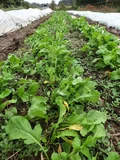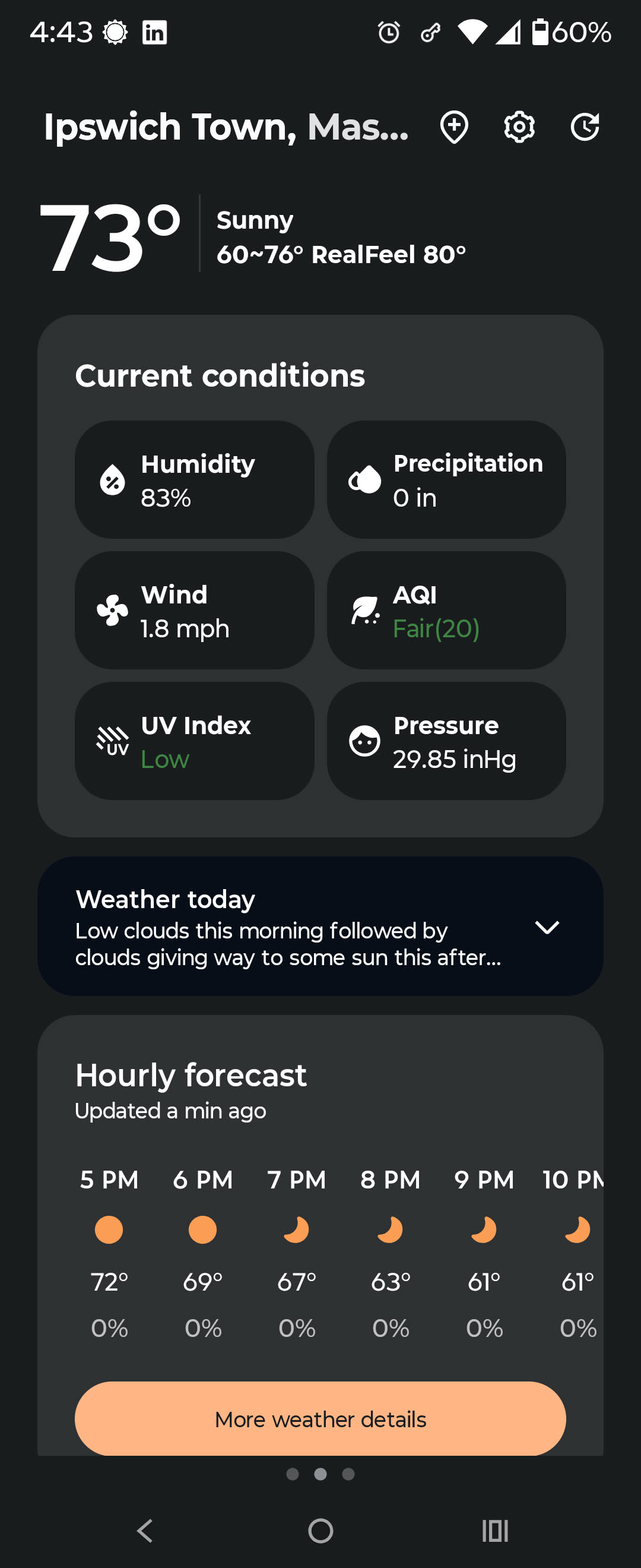TL;DR
We harvested eggplants, peppers, and arugula (a.k.a. rocket) then packed up for deliveries and the farmer’s market.
An Arugula by Any Other Name
In the UK, they call it rocket (pro. “row-kit”) but it will always be “arugula” to me. I remember the first time I had it in a salad as a teen and almost choked because I wasn’t expecting it to be so spicy and inhaled a piece of one of the leaves.
Arugula is a leafy green that is quick to grow in warm soil with minimal care. It tastes bright and grassy with a peppery bite. In fancy restaurants, it is often tossed with a light vinaigrette and served with a goat cheese cake, sometimes with candied walnuts or an almond encrusting too. Don’t get me wrong, this is great, but you really have to be in the mood for it.
Like most leafy greens, it spoils quickly if not stored properly, so it’s best to use it as soon as possible. I especially like it chopped and tossed on top of a soup, particularly for dinner on a damp and chilly day like this one started out as, but quickly warmed up when the sun came out.
We seeded this patch about a month ago then kept it under row cover so that the flea beetles and deer wouldn’t bother it too much. Harvesting it is simple: grab a bunch between your thumb and index finger loop then swiftly chop (not saw) through the stems at about 2-3 inches above the soil to get the most of the leafy bits and very little weeds or dirt.
It will continue to grow new leaves from the base a few times before the season is over, and these new growths will be quicker to produce than the first harvest during root establishment, despite less sunlight per day as the winter season approaches.
Back to My Futures
While working today, I had numerous moments where I found my mind wandering to what my career would look like in a year, three years, a decade. In the face of the high tech industry imploding on itself thanks to a hype cycle around AI, I don’t know if I want to be part of that insanity again so soon since departing it last year.
I would love to start my own business but haven’t quite nailed down exactly how that will work and what to focus on. Post-farm production of value-added agricultural products seems to be a promising area of potential. IT consulting for farms would be stellar, but drumming up customers not to mention adequate income from them makes this a less likely option.
In October and November, I am likely going to take the Farm Business Planning Course from New Entry Sustainable Farming Project in Beverly. This is not only a pre-requisite to potentially using their incubator farm space in the future but also recognized by the Farm Service Agency (FSA) as fulfilling one of their financial management training requirements.
Maybe I’ll finally write a book…“The Sunshine Cafe”…kind of a cookbook and movie recommendations mash-up based on a long-standing idea of me and mine for a combo diner and drive-in movie theater that approximates one we once visited in Vermont. This will not make money which is what I need.
Or I could just get a full-time job like a normal person.
AI Summary from Field Notes
Case in point about the need for better AI training that is organic farming specific. I really stumped Qwen3 today when it couldn’t connect the dots about excess water being a cause of faster decomposition in food. It generated:
“Why is washing plants bad for refrigeration?” (The intern notes that washing speeds up decomposition, but the reasoning is not explained.)
One would thing that somewhere, out in the wide world of the public intarwebs, that there’s more than enough content about how to keep various produce from rotting under the presence of too much water. Yes, different produce needs different levels of moisture. But anyone who’s wondered why fruits and veg go faster than…say… cooked rice in the fridge knows, it’s about the water content. In particular:
water supports the survival and activity of the microorganisms (like bacteria and fungi) that break down organic matter, providing the necessary environment for their metabolism, transport, and enzyme secretion. A lack of water inhibits microbial growth, allowing for longer food preservation, whereas the addition of water creates ideal conditions for these decomposers, accelerating the decay process
…so Google AI search says. All we need to do is teach my process to reach out to Google for additional search results in a RAG model (that I’ve been deferring the work on since May). For now, 95% awesome summary will just have to do.
Summary
Consolidated Summary
Main Themes
- Farm Operations and Labor: Daily tasks, crop management, and infrastructure maintenance (e.g., irrigation, coops).
- Collaboration: Teamwork among farm staff, including decisions on crop handling and logistics.
- Sustainable Practices: Crop storage techniques (e.g., washing vs. unwashing) and decomposition rates.
- Logistics and Distribution: CSA delivery systems, field layout, and crop zoning.
- Infrastructure Management: Movement of farm equipment (e.g., coops, irrigation systems).
Key Activities
- Crop harvesting and storage (e.g., washing vs. unwashing).
- Maintenance of irrigation systems and meat bird coops.
- Organizing and distributing CSA shares (full/half shares to Beverly, Salem).
- Mapping fields for specific crops (e.g., beets, eggplants, arugula).
- Documenting farm layout and infrastructure.
New Observations
- Crop Handling Decisions: Crops are washed or unwashed based on storage needs.
- Field Zoning: Clear separation of fields for different crops.
- Coop and Irrigation Movement: Regular relocations of infrastructure.
- CSA Logistics: Specific delivery routes and share distribution.
- Decomposition Science: Washing speeds up decomposition, but rationale not fully explained.
Key Questions
- Why does washing speed up decomposition, and how is this decision made?
- What criteria determine which crops are washed vs. unwashed?
- How is the meat bird coop and irrigation system managed?
- How are fields divided for crop types?
- What impact does not washing eggplants have on shelf life or quality?
- How does the farm schedule irrigation and harvesting?
Recommended Actions
- Investigate Decomposition Science: Study the impact of washing on crop preservation.
- Map Farm Infrastructure: Document field zones, coops, and irrigation systems.
- Optimize CSA Processes: Analyze efficiency in share distribution and packaging.
- Track Infrastructure Movement: Record timelines for coop and irrigation relocations.
- Clarify Crop Handling Policies: Interview staff to understand decision-making.
- Document Storage Practices: Create guidelines for washing/unwashing based on crop type.
Part 1
Main Themes
- Farm Operations and Labor: Daily tasks involving harvesting, washing, and processing produce, as well as animal care and infrastructure maintenance.
- Collaboration: Working with Jamie (the farmer) and another person, emphasizing teamwork and shared responsibilities.
- Crop Management: Harvesting and preparing multiple crops (eggplants, peppers, tomatoes, mizuna, arugula) and understanding their storage and handling.
- Market Preparation: Organizing CSA deliveries, packaging produce, and logistical planning for distribution.
- Sustainable Practices: Observing how washing and refrigeration affect decomposition, and decisions about crop handling.
Activities Performed by the Intern
- Washed buckets (as many as possible) in the morning.
- Helped Jamie with chicken and pig chores.
- Harvested eggplants, green peppers, and tomatoes.
- Washed and binned peppers and arugula, while keeping eggplants un-washed.
- Bagged mizuna for CSA deliveries and market distribution.
- Moved irrigation and the meat bird coop.
- Weeded beets in a specific field.
- Prepared and loaded CSA delivery bags.
- Drove to the market (in the intern’s car) while Jamie drove the electric van.
- Watered pigs and chickens after lunch.
New Things Not Yet Encountered
- Crops and Storage: The intern observed that some crops (e.g., eggplants) are not washed before refrigeration to prevent faster decomposition.
- Crop Varieties: Harvesting multiple varieties of eggplants and using different buckets for different crops.
- Coop and Irrigation Management: Moving the meat bird coop and adjusting irrigation systems.
- CSA Logistics: Organizing and delivering CSA shares (full and half shares) to specific areas (Beverly, Salem).
- Field Layout: The farm’s layout, including specific fields for beets, eggplants, and arugula.
Questions and Future Research Areas
- Why is washing plants bad for refrigeration? (The intern notes that washing speeds up decomposition, but the reasoning is not explained.)
- How does the farm decide which crops to wash and which to leave unwashed?
- What is the process for moving the meat bird coop and irrigation?
- How are the fields divided for different crops (e.g., eggplants, peppers, beets)?
- What is the impact of not washing eggplants on their shelf life or quality?
- How does the farm handle the timing of irrigation and crop harvesting?
Suggestions for Action
- Document the rationale for washing vs. not washing crops: Investigate the science behind decomposition rates and storage practices.
- Map the farm’s field layout: Create a visual or written record of crop zones and infrastructure (coops, irrigation).
- Analyze CSA delivery processes: Study how shares are organized, packaged, and distributed to optimize efficiency.
- Track the movement of the meat bird coop: Record the timeline and reasons for its relocation.
- Research decomposition and storage practices: Explore how different crops are handled to minimize spoilage.
- Interview Jamie or other staff: Clarify decisions about crop handling, irrigation, and coop management.
[end of post]
Enjoy Reading This Article?
Here are some more articles you might like to read next:





